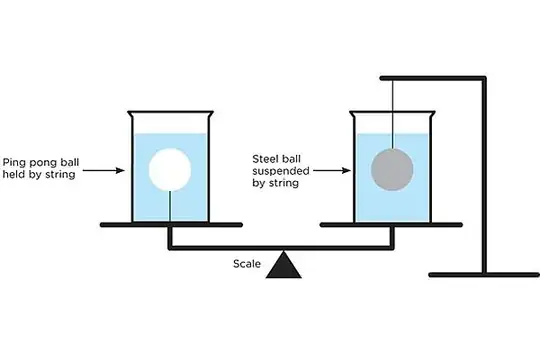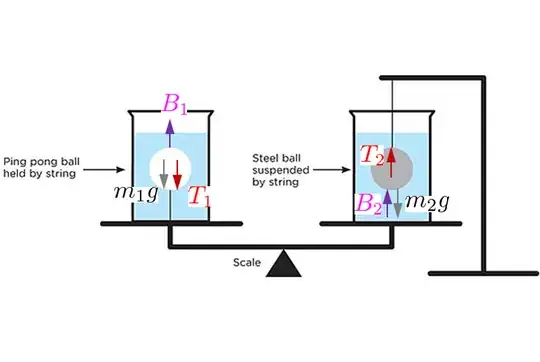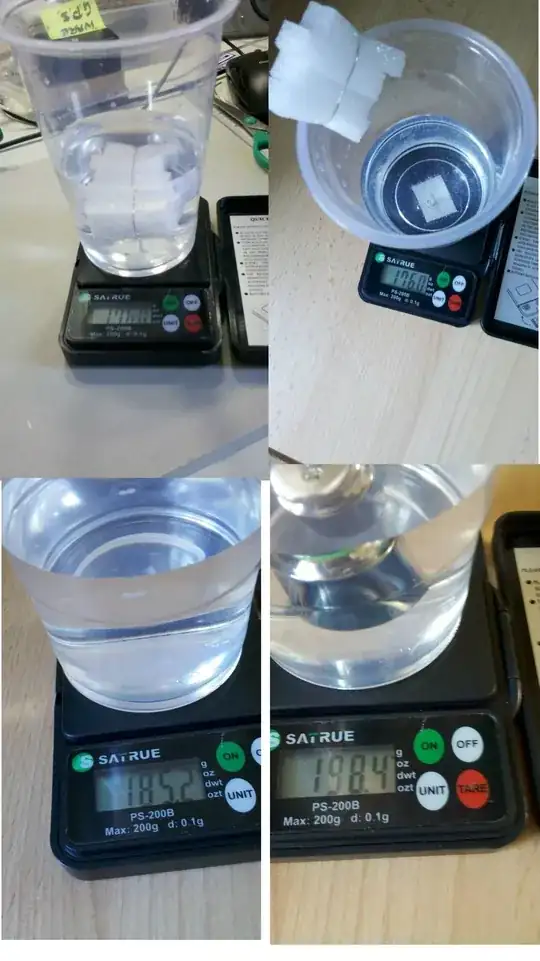I'm amazed that this is so confounding to some. This is too long to be a comment, so I'm making it an answer. The TL;DR version: The answers that say the scale will tilt down to the right are correct. The beaker full of water with the steel ball suspended from above is heavier than is the beaker that contains the ping pong ball anchored from below.
Assumptions
- The two flasks are identical. To make this so, down to the splitting of hairs, let's attach a connector to the bottom of both flasks. The connector will be used to anchor the ping pong ball on the left to the bottom. We need that same connector, unused, on the right so as to make the flasks identical.
- The two flasks contain identical quantities of water.
- The ping pong ball and steel ball are the same size and are fully suspended in the water.
- The ping pong ball is less dense than water while the steel ball is of course more dense than water.
- The strings are of negligible mass.
- The scales are very sensitive and can detect differences in mass to the sub-centrigram level.
Experiment #1: Anchored ping pong ball on the left, no steel ball on the right
This one's easy: The left side is heavier. A simple explanation is to look at the water+ping pong ball on the left as a system. This system is static, so the net force is zero. The mass of the system is the sum of the masses of the water and the ball: $m_{w+b}=m_w + m_b$. Gravity exerts a downward force of $g m_{w+b} = g(m_w+m_b)$. Ignoring atmospheric pressure, the only other force is that of the bottom of the flasks on the water. This must exactly oppose the weight of the water+ball system to have a net force of zero. Thus the force transmitted to the left side of the scale is $W_l = g(m_f+m_w+m_b)$ where $m_f$ is the mass of the flask. On the right, there's only the mass of the water and the flask, so the force transmitted to the scale on the right is $g(m_f+m_w)$, or $g m_b$ less than that on the left. The scale tips down to the left.
Note that I ignored the forces on the string, buoyancy, and pressure. Invoking these results in the same answer as above, but with a lot more effort. The ball has three forces acting on it, gravitation ($W_b = g m_b$, downward), buoyancy ($B=g \rho_w V_b$, upward), and tension ($T$, downward). The ball is static, so $T+W_b = B$, or $T=B-W_b$. The water has three forces acting on it, gravitation ($W_w = g m_w$, downward), the third law counter to the buoyant force the water exerts on the ball ($B = g \rho_w V_b$, but now directed downward rather than upward), and the force by the bottom of the flask on the water ($F_p$ upward). The net force on the water is zero, so $F_p = W_w + B$. The forces on the bottom of the flask are the tension in the string, directed upward, and the pressure force from the water, directed downward: $F_f = F_p - T = (W_w + B) - (B-W_b) = W_w + W_b = g(m_w + m_b)$.
Some will say "but how does the reaction force to buoyancy transmit to the bottom of the flask?" Note that I didn't invoke Newton's third law in the context of the counter to the buoyant force eventually acting on the bottom of the flask. I used static analysis. The explanation of how this force is eventually transmitted to the bottom of the flask is via pressure. The force by the flask on the water is equal but opposite to the force by the water on the flask, and this is pressure times area. The presence of the ball raises the height of the top of the water by an amount needed to accommodate the volume of the ball, and this increases the pressure at the bottom of the flask. If the flask is cylindrical, this is a fairly easy computation: $\Delta h = V_b/A$, and thus $\Delta P = \rho g \Delta h A = \rho g V_b$. That's the magnitude of the buoyancy force.
Experiment #2: No ping pong ball on the left, suspended steel ball on the right
Now the scale will tilt down to the right. There's an easy way, a hard way, and a harder way to solve this. The harder way involves pressure, and the result will be the same as the other two approaches. I'll bypass pressure. The easy way is a static analysis. The water exerts a buoyant force on the ball, which exerts an equal but opposite force on the water. The water is static, so the bottom of the flask exerts a force on the water equal to the sum of its weight and the magnitude of the buoyant force: $W_w + B = g m_w + B$. Adding the weight of the flask gives the total weight on the right: $W_r = g(m_f + m+w) + B$. On the left, all we have is the weight of the flask and the water. The scale tilts down to the right.
Experiment #3: Anchored ping pong ball on the left, suspended steel ball on the right
Now we know the weight registered by the flask+water+ping pong ball system on the left and the weight registered by the flask+water+suspended steel ball system ob the right. It's a simple matter of comparing the two: $W_r - W_l = g(m_f + m+w) + B - g(m_f+m_w+m_b) = B - g m_b$. Since the ping pong ball floats, $B>g m_b$, so the scale tilts down to the right.
Experiment #4: Same as experiment #2, but now add water on the left
We can simply add water to the flask on the left in experiment #2 to make the scale balance. When we do that, we'll see that the scales balance when the water levels in the two flasks are at exactly the same height above the bottom of the flask. (This is the pressure argument.) If we measure the amount of water added, it will be equal in volume to the volume of the ball. (This is the buoyancy argument).
Experiment #5: Anchored ping pong ball on the left, left flask from experiment #4 on the right
Since the two flasks in experiment #4 have the same weight, the scale will still tilt down to the right, just as in experiment #3. If we look at the two flasks, we'll see that the water level in them is the same.
Experiment #6: Anchored ping pong ball on the left, anchored crushed ping pong ball on the right
Here we replace the steel ball in experiment #3 with a crushed ping pong ball anchored from the bottom. Since the buoyant force cancels out in the ping pong ball+water system (see experiment #1), one might think that the intact versus crushed ping pong ball test will balance. That is not the case. The intact ping pong ball weighs a tiny bit more. It has about 4 centigrams of air inside it. This is part of the measurement on the left but not on the right. The system with the intact ping pong ball is slightly heavier. Since our scale is accurate to the sub-centigram level, the scale will tilt down to the left in this experiment.
The above is incorrect. The water level will be a bit lower on the crushed ping pong ball side. Unless ping pong balls are inflated to considerably more than atmospheric pressure, the slightly increased pressure on the crushed ping pong ball side will more or less compensate for the reduction in mass.
Experiment #7: Replace the steel ball in experiment #2 with an intact ping pong ball
Finally, let's replace the string attached to the tower that suspends the steel ball in the water with a rigid rod attached to the tower that forces a ping pong ball to be immersed underwater. The result will be identical to experiment #2. The buoyant force is equal to volume, not mass. It doesn't matter what kind of ball we use so long as the volume remains the same. The effect on the tower will of course be markedly different, but the tower is not a part of the systems we are weighing.



 .
The first photo (top left) shows the cup with water and a piece of plastic tethered to the bottom of it. The second (top right) has the plastic removed and hung on the rim of the cup, above the water and shows that there is no difference in the weight. This was what I expected. The third image (bottom left) shows the water alone (the hook came off and I discarded it) , note the weight, and the final photo has a 100 gm steel test weight suspended in the water, and, to my initial surprise, the weight shown on the scale has gone up. So the correct conclusion is that the right hand pan will descend.
.
The first photo (top left) shows the cup with water and a piece of plastic tethered to the bottom of it. The second (top right) has the plastic removed and hung on the rim of the cup, above the water and shows that there is no difference in the weight. This was what I expected. The third image (bottom left) shows the water alone (the hook came off and I discarded it) , note the weight, and the final photo has a 100 gm steel test weight suspended in the water, and, to my initial surprise, the weight shown on the scale has gone up. So the correct conclusion is that the right hand pan will descend.